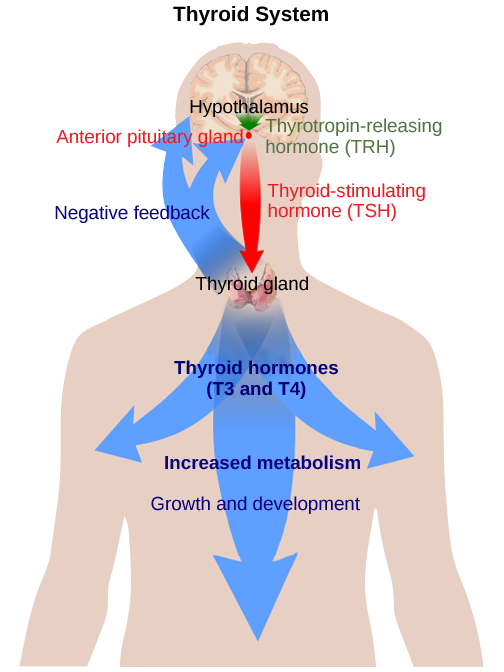| << Chapter < Page | Chapter >> Page > |
The kidneys also possess endocrine function. Erythropoietin (EPO) is released by kidneys in response to low blood oxygen levels. EPO triggers an increase in the rate of production of red blood cells in the red bone marrow. EPO has been used by athletes (e.g. cyclists) to improve performance because more RBCs mean more oxygen can be transported. However, EPO doping has its risks, because it thickens the blood and increases strain on the heart; it also increases the risk of blood clots and therefore heart attacks and stroke.
| Endocrine Glands and Their Associated Hormones | ||
|---|---|---|
| Endocrine Gland | Associated Hormones | Effect |
| Pituitary (anterior) | growth hormone | promotes growth of body tissues |
| prolactin | promotes milk production | |
| thyroid-stimulating hormone | stimulates thyroid hormone release | |
| adrenocorticotropic hormone | stimulates hormone release by adrenal cortex | |
| follicle-stimulating hormone | stimulates gamete production | |
| luteinizing hormone | stimulates androgen production by gonads in males; stimulates ovulation and production of estrogen and progesterone in females | |
| Pituitary (posterior) | antidiuretic hormone | stimulates water reabsorption by kidneys |
| oxytocin | stimulates uterine contractions during childbirth | |
| Thyroid | thyroxine, triiodothyronine | stimulate metabolism |
| calcitonin | reduces blood Ca 2+ levels | |
| Parathyroid | parathyroid hormone | increases blood Ca 2+ levels |
| Adrenal (cortex) | aldosterone | increases blood Na + levels |
| cortisol, corticosterone, cortisone | increase blood-glucose levels | |
| Adrenal (medulla) | epinephrine, norepinephrine | stimulate fight-or-flight response |
| Pancreas | insulin | reduces blood-glucose levels |
| glucagon | increases blood-glucose levels |
Hormone production and release are primarily controlled by negative feedback, as described in the discussion on homeostasis. In this way, the concentration of hormones in blood is maintained within a narrow range. For example, the anterior pituitary signals the thyroid to release thyroid hormones. Increasing levels of these hormones in the blood then give feedback to the hypothalamus and anterior pituitary to inhibit further signaling to the thyroid gland ( [link] ).

Hormones cause cellular changes by binding to receptors on or in target cells. The number of receptors on a target cell can increase or decrease in response to hormone activity.
Hormone levels are primarily controlled through negative feedback, in which rising levels of a hormone inhibit its further release.
The pituitary gland is located at the base of the brain. The anterior pituitary receives signals from the hypothalamus and produces six hormones. The posterior pituitary is an extension of the brain and releases hormones (antidiuretic hormone and oxytocin) produced by the hypothalamus. The thyroid gland is located in the neck and is composed of two lobes. The thyroid produces the hormones thyroxine and triiodothyronine. The thyroid also produces calcitonin. The parathyroid glands lie on the posterior surface of the thyroid gland and produce parathyroid hormone.
The adrenal glands are located on top of the kidneys and consist of the adrenal cortex and adrenal medulla. The adrenal cortex produces the glucocorticoids, mineralocorticoids, and gonadocorticoids. The adrenal medulla is the inner part of the adrenal gland and produces epinephrine and norepinephrine.
The pancreas lies in the abdomen between the stomach and the small intestine. Clusters of endocrine cells in the pancreas form the islets of Langerhans, which contain alpha cells that release glucagon and beta cells that release insulin. The kidneys produce erythropoietin. The gonads produce steroid hormones, including testosterone in males and estrogen and progesterone in females.
Goiter, a disease caused by iodine deficiency, results in the inability of the thyroid gland to form T 3 and T 4 . The body typically attempts to compensate by producing greater amounts of TSH. Which of the following symptoms would you expect goiter to cause?
[link] A

Notification Switch
Would you like to follow the 'Human biology' conversation and receive update notifications?